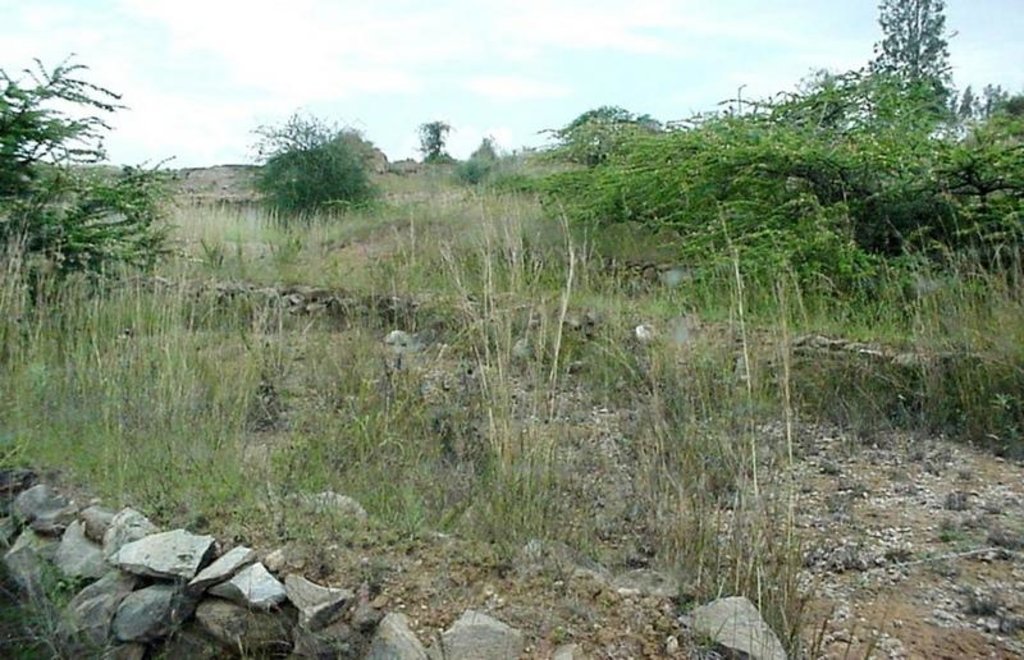Area closure for rehabilitation [Etiópia]
- Criação:
- Atualização:
- Compilador/a: Daniel Danano
- Editor: –
- Revisores: Fabian Ottiger, Donia Mühlematter, Alexandra Gavilano
Meret mekelel
technologies_1048 - Etiópia
Veja as seções
Expandir tudo Recolher tudo1. Informação geral
1.2 Detalhes do contato das pessoas capacitadas e instituições envolvidas na avaliação e documentação da tecnologia
Nome do projeto que facilitou a documentação/avaliação da Tecnologia (se relevante)
Book project: where the land is greener - Case Studies and Analysis of Soil and Water Conservation Initiatives Worldwide (where the land is greener)Nome da(s) instituição(ões) que facilitou(ram) a documentação/ avaliação da Tecnologia (se relevante)
Ministry of Agriculture and Rural Development (Ministry of Agriculture and Rural Development) - Etiópia1.3 Condições em relação ao uso da informação documentada através de WOCAT
O compilador e a(s) pessoa(s) capacitada(s) aceitam as condições relativas ao uso de dados documentados através do WOCAT:
Sim
1.4 Declaração de sustentabilidade da tecnologia descrita
A tecnologia descrita aqui é problemática em relação a degradação da terra de forma que não pode ser declarada uma tecnologia de gestão sustentável de terra?
Não
2. Descrição da tecnologia de GST
2.1 Descrição curta da tecnologia
Definição da tecnologia:
Enclosing and protecting an area of degraded land from human use and animal interference, to permit natural rehabilitation, enhanced by additional vegetative and structural conservation measures.
2.2 Descrição detalhada da tecnologia
Descrição:
Area closure involves the protection and resting of severely degraded land to restore its productive capacity. There are two major types of area enclosures practised in Ethiopia: (1) the most common type involves closing of an area from livestock and people so that natural regeneration of the vegetation can take place; (2) the second option comprises closing off degraded land while simultaneously implementing additional measures such as planting of seedlings, mulching and establishing water harvesting structures to enhance and speed up the regeneration process. The focus of this case study is on this second type.
The selection of measures chosen for rehabilitation depends mainly on the land use type, and to a lesser extent on climate, topography and soil type. Degraded croplands with individual land use rights are normally treated with additional structural measures to retain soil moisture and trap sediment, and with agronomic measures to restore soil fertility. Open access grazing lands are closed for natural regeneration while partly treated with additional measures, and open access woodlands are simply closed. In the case study area 60% of the enclosed area is under treatment with additional conservation measures and 40% is under natural regeneration. First, the area to be closed is demarcated and protected with fencing, usually live fences, and a site guard may be assigned to further ensure protection. Structural measures such as micro-basins, trenches, and bunds that enhance water infiltration and soil moisture may be constructed to increase survival rate of vegetative material planted. Hillside terraces, spaced at a 1 m vertical interval with a width of 1 m are constructed on steep slopes (exceeding 20%). Nitrogen-fixing and multipurpose shrubs/trees (for fodder, fuel) such as Acacia saligna, Sesbania sesban, Leucaena leucocephala as well as local grass species such as napier (Pennisetum purpureum) and rhodes (Chloris gayana) are planted as additional measures for conservation.
The maintenance of area enclosures involves activities such as replanting, maintaining of fences, pruning of trees and weeding. After one year, cut-and-carry of grass for stall-feeding can be partly practiced - which is of economic benefit to the farmers. Rehabilitation normally takes about 7-10 years depending on the level of degradation and intensity of management. Land use is limited to selective cutting of trees, collection of dead wood and cut-and-carry of grass for livestock fodder. On individually owned enclosures land users start cutting trees after three years (for eucalyptus) and after 7–8 years (for other trees), while on communal land farmers are allowed to collect dead wood after 3-–4 years, and the community decides about the use of trees.
2.3 Fotos da tecnologia
2.5 País/região/locais onde a tecnologia foi aplicada e que estão cobertos nesta avaliação
País:
Etiópia
Região/Estado/Província:
Alaba, South Ethiopia
Especificação adicional de localização:
Bilate River Catchment (Rift Valley)
Comentários:
Total area covered by the SLM Technology is 20 km2.
Map
×2.7 Introdução da tecnologia
Especifique como a tecnologia foi introduzida:
- através de projetos/intervenções externas
3. Classificação da tecnologia de GST
3.1 Principal/principais finalidade(s) da tecnologia
- Melhora a produção
- Reduz, previne, recupera a degradação do solo
- Preserva ecossistema
3.2 Tipo(s) atualizado(s) de uso da terra onde a tecnologia foi aplicada
Uso do solo misturado dentro da mesma unidade de terra:
Sim
Especificar o uso misto da terra (culturas/ pastoreio/ árvores):
- Silvipecuária

Terra de cultivo
- Cultura perene (não lenhosa)
- Cultura de árvores e arbustos
- napier (Pennisetum purpureum), rhodes (Chloris gayana)
- Acacia saligna, Sesbania sesban, Leucaena leucocephala, Eucalyptus, Grevillea robusta
Especifique:
Longest growing period in days: 120 Longest growing period from month to month: Jun - Sep

Pastagem
Pastagem intensiva/produção de forragem:
- Semiestabulação/sem pastagem
Comentários:
Major land use problems (compiler’s opinion): Over 30% of the land in the study area is degraded, resulting in low crop yields and poor livestock production. Severe water erosion is the main cause of land degradation on all slopes, followed by fertility depletion due to intensive cultivation practices and overgrazing. Serious gully formation and a high sediment load in the Bilate River threaten Lake Abaya. Communal grazing lands, woodlands with open access, and cultivated lands on steep slopes without conservation measures are particularly affected. By tradition, land users in rural Ethiopia can own as many livestock as they wish, which encourages overstocking.
Ranching: (before SWC)
Other grazingland: mixed silvo-pastoral (after SWC): cut-and-carry, trees
3.3 O uso do solo mudou devido à implementação da Tecnologia?
Uso do solo misturado dentro da mesma unidade de terra:
Sim
3.4 Abastecimento de água
Abastecimento de água para a terra na qual a tecnologia é aplicada:
- Precipitação natural
3.5 Grupo de GST ao qual pertence a tecnologia
- Reserva ( suspensão do uso, apoio à recuperação)
- Medidas de curva de nível
3.6 Medidas de GST contendo a tecnologia
3.7 Principais tipos de degradação da terra abordados pela tecnologia

Erosão do solo pela água
- Wt: Perda do solo superficial/erosão de superfície
- Wg: Erosão por ravinas/ravinamento
- Wo: efeitos de degradação externa

Deteriorização química do solo
- Cn: declínio de fertilidade e teor reduzido de matéria orgânica (não causado pela erosão)

Degradação biológica
- Bc: redução da cobertura vegetal
- Bs: Qualidade e composição de espécies/declínio de diversidade
Comentários:
Main type of degradation addressed: Wt: loss of topsoil / surface erosion, Wg: gully erosion / gullying, Wo: offsite degradation effects, Cn: fertility decline and reduced organic matter content, Bc: reduction of vegetation cover, Bs: quality and species composition /diversity decline
3.8 Redução, prevenção ou recuperação da degradação do solo
Especifique o objetivo da tecnologia em relação a degradação da terra:
- Recuperar/reabilitar solo severamente degradado
4. Especificações técnicas, implementação de atividades, entradas e custos
4.1 Desenho técnico da tecnologia
Especificações técnicas (relacionada ao desenho técnico):
Rehabilitation of degraded land based on enclosure with live fence. Natural regeneration of vegetative cover is supported by water harvesting structures and planting of nitrogen-fixing/multipurpose shrubs and trees as well as local grass species. On steeper slopes hillside terraces may be established.
Technical knowledge required for field staff / advisors: moderate
Technical knowledge required for land users: moderate
Main technical functions: improvement of ground cover, increase of infiltration, control of dispersed runoff, control of concentrated runoff, increase in soil fertility
Secondary technical functions: increase / maintain water stored in soil, less sediment deportation
Mulching
Material/ species: tree leaves/grass
Scattered / dispersed
Vegetative material: T : trees / shrubs
Vegetative measure: oversowing grasses
Vegetative material: G : grass
Vegetative measure: Vegetative material: G : grass
Vegetative measure: Vegetative material: G : grass
Vegetative measure: Vegetative material: G : grass
Trees/ shrubs species: Acacia saligna, Sesbania sesban, Leucaena leucocephala, Eucalyptus spp., Grevillea robusta
Grass species: nepier (Pennisetum purpureum), rhodes (Chloris gayana)
Structural measure: micro-basins (opt.)
Structural measure: terraces (opt.)
Structural measure: bunds (opt.)
Other type of management: land use change, enclosure,, cut-and-carry
Autor:
Mats Gurtner
4.3 Atividades de implantação
| Atividade | Periodicidade (estação do ano) | |
|---|---|---|
| 1. | Planting of trees (Eucalyptus spp., Grevillea robusta) as well as | (early rainy season). |
| 2. | Oversowing/interplanting with local grass species: napier grass | (early rainy season). |
| 3. | Marking the boundary and establishment of live fences: digging pits | early rainy season (before June). |
| 4. | Construction of structural measures such as micro- basins, trenches, bunds or hillside terraces. | before rains |
4.4 Custos e entradas necessárias para a implantação
| Especifique a entrada | Unidade | Quantidade | Custos por unidade | Custos totais por entrada | % dos custos arcados pelos usuários da terra | |
|---|---|---|---|---|---|---|
| Mão-de-obra | Labour | ha | 1,0 | 175,0 | 175,0 | 50,0 |
| Equipamento | Tools | ha | 1,0 | 25,0 | 25,0 | 100,0 |
| Material vegetal | Seeds | ha | 1,0 | 40,0 | 40,0 | |
| Material vegetal | Seedlings | ha | 1,0 | 150,0 | 150,0 | |
| Material de construção | Stone | ha | 1,0 | |||
| Material de construção | Wood | ha | 1,0 | |||
| Outros | site guard (kg grain/ha/year) | ha | 1,0 | 1,0 | 1,0 | 100,0 |
| Custos totais para a implantação da tecnologia | 391,0 | |||||
| Custos totais para o estabelecimento da Tecnologia em USD | 391,0 | |||||
Comentários:
Duration of establishment phase: 2 month(s)
4.5 Atividades recorrentes/manutenção
| Atividade | Periodicidade/frequência | |
|---|---|---|
| 1. | Mulching with tree leaves/grass around newly planted trees, before | before rains / initial establishment |
| 2. | Replanting/gapping up live fence and trees during rains in the early | during rains / |
| 3. | Harvesting grass | during rainy season. / |
| 4. | Pruning of trees | in the dry season. / |
| 5. | Weeding | after rains. / |
| 6. | Repairing breaks in structures | before rains./ |
4.6 Custos e entradas necessárias pata a manutenção/atividades recorrentes (por ano)
| Especifique a entrada | Unidade | Quantidade | Custos por unidade | Custos totais por entrada | % dos custos arcados pelos usuários da terra | |
|---|---|---|---|---|---|---|
| Mão-de-obra | Labour | ha | 1,0 | 35,0 | 35,0 | 100,0 |
| Equipamento | Tools | ha | 1,0 | 5,0 | 5,0 | 100,0 |
| Material vegetal | Seeds | ha | 1,0 | 10,0 | 10,0 | |
| Material vegetal | Seedlings | ha | 1,0 | 40,0 | 40,0 | |
| Outros | site guard (kg grain/ha/year) | ha | 1,0 | 1,0 | 1,0 | 100,0 |
| Custos totais para a manutenção da tecnologia | 91,0 | |||||
| Custos totais de manutenção da Tecnologia em USD | 91,0 | |||||
Comentários:
Labour for establishment activities: 250 person days per ha for structural measures and planting of trees, plus guarding. Labour for maintenance: 50 person days for replanting/weeding. A common daily wage is US$ 0.70 (= 6 Ethiopian Birr), however in this case the site guards were given 3 kg of grains per ha per year. They can control over 200 ha.
5. Ambiente natural e humano
5.1 Clima
Precipitação pluviométrica anual
- <250 mm
- 251-500 mm
- 501-750 mm
- 751-1.000 mm
- 1.001-1.500 mm
- 1.501-2.000 mm
- 2.001-3.000 mm
- 3.001-4.000 mm
- > 4.000 mm
Especificações/comentários sobre a pluviosidade:
751-1,000 mm (ranked 1)
1,001-1,500 mm (ranked 2)
Zona agroclimática
- Subúmido
Thermal climate class: tropics
5.2 Topografia
Declividade média:
- Plano (0-2%)
- Suave ondulado (3-5%)
- Ondulado (6-10%)
- Moderadamente ondulado (11-15%)
- Forte ondulado (16-30%)
- Montanhoso (31-60%)
- Escarpado (>60%)
Formas de relevo:
- Planalto/planície
- Cumes
- Encosta de serra
- Encosta de morro
- Sopés
- Fundos de vale
Zona de altitude:
- 0-100 m s.n.m.
- 101-500 m s.n.m.
- 501-1.000 m s.n.m.
- 1.001-1.500 m s.n.m.
- 1.501-2.000 m s.n.m.
- 2.001-2.500 m s.n.m.
- 2.501-3.000 m s.n.m.
- 3.001-4.000 m s.n.m.
- > 4.000 m s.n.m.
Comentários e outras especificações sobre a topografia:
Altitudinal zone: Also 1,001-1,500 m a.s.l. (ranked 2) and 2001-2500 m a.s.l. (ranked 3)
Slopes on average: Also hilly (ranked 2) and moderate (ranked 3)
5.3 Solos
Profundidade do solo em média:
- Muito raso (0-20 cm)
- Raso (21-50 cm)
- Moderadamente profundo (51-80 cm)
- Profundo (81-120 cm)
- Muito profundo (>120 cm)
Textura do solo (solo superficial):
- Grosso/fino (arenoso)
- Médio (limoso, siltoso)
Matéria orgânica do solo superficial:
- Baixo (<1%)
Caso disponível anexe a descrição completa do solo ou especifique as informações disponíveis, p. ex. tipo de solo, PH/acidez do solo, nitrogênio, capacidade de troca catiônica, salinidade, etc.
Soil depth on average: Also moderately deep (ranked 2) and deep (ranked 3)
Soil fertility: Low
Topsoil organic matter: Also medium and high (both ranked 2)
Soil drainage/infiltration: Good
Soil water storage capacity: Very high
5.6 Características dos usuários da terra que utilizam a tecnologia
Orientação de mercado do sistema de produção:
- Subsistência (autoabastecimento)
Rendimento não agrícola:
- Menos de 10% de toda renda
Indique outras características relevantes dos usuários da terra:
Off-farm income specification: from petty trade, weaving, etc
5.7 Área média de terrenos utilizados pelos usuários de terrenos que aplicam a Tecnologia
- < 0,5 ha
- 0,5-1 ha
- 1-2 ha
- 2-5 ha
- 5-15 ha
- 15-50 ha
- 50-100 ha
- 100-500 ha
- 500-1.000 ha
- 1.000-10.000 ha
- > 10.000 ha
5.8 Propriedade de terra, direitos de uso da terra e de uso da água
Propriedade da terra:
- Estado
Direitos do uso da terra:
- Acesso livre (não organizado)
- Indivíduo
6. Impactos e declarações finais
6.1 Impactos no local mostrados pela tecnologia
Impactos socioeconômicos
Produção
Produção de forragens
Comentários/especificar:
(cut-and-carry of grass)
Qualidade da forragem
Comentários/especificar:
(cut-and-carry of grass)
Produção de madeira
Área de produção
Comentários/especificar:
Reduction of grazing area leads to high pressure on remaining grazing areas
Renda e custos
Despesas com insumos agrícolas
Rendimento agrícola
Comentários/especificar:
(selling grass/wood)
Carga de trabalho
Impactos socioculturais
Instituições comunitárias
Conhecimento de GST/ degradação da terra
Atenuação de conflitos
Comentários/especificar:
Unequal share of benefits, some illegal cutting of vegetation is involved
Impactos ecológicos
Ciclo hídrico/escoamento
Drenagem de excesso de água
Solo
Umidade do solo
Comentários/especificar:
>50%
Cobertura do solo
Comentários/especificar:
>80%
Perda de solo
Comentários/especificar:
initially 50% reduction, after 2–3 years
Outros impactos ecológicos
Soil fertility
Comentários/especificar:
increased organic matter, nitrogen fixing shrubs
Biodiversity
Comentários/especificar:
recovering disappearing local species
competition between (grass)species
Comentários/especificar:
competition between naturally regenerating and oversown (grass)species
6.2 Impactos externos mostrados pela tecnologia
Caudal confiável e estável em período seco
Comentários/especificar:
Also groundwater recharge
Cheias de jusante
Sedimentação a jusante
Comentários/especificar:
Less sediment transported
Poluição de água subterrânea/rio
6.4 Análise do custo-benefício
Como os benefícios se comparam aos custos de implantação (do ponto de vista dos usuários da terra)?
Retornos a curto prazo:
positivo
Retornos a longo prazo:
muito positivo
Como os benefícios se comparam aos custos recorrentes/de manutenção(do ponto de vista dos usuários da terra)?
Retornos a curto prazo:
positivo
Retornos a longo prazo:
muito positivo
6.5 Adoção da tecnologia
De todos aqueles que adotaram a Tecnologia, quantos o fizeram espontaneamente, ou seja, sem receber nenhum incentivo/ pagamento material?
- 91-100%
Comentários:
300 land user families have adopted the Technology with external material support
90% of land user families have adopted the Technology without any external material support
There is a moderate trend towards spontaneous adoption of the Technology
Comments on adoption trend: Adoption rate has considerably increased owing to improved ownership feeling and immense benefits obtained through the practice. However, if labour-intensive structural measures are required people rely on food-for-work incentives.
6.7 Pontos fortes/vantagens/oportunidades da tecnologia
| Pontos fortes/vantagens/oportunidades na visão do compilador ou de outra pessoa capacitada |
|---|
|
Reduction of on-site and off-site land degradation, reclamation of degraded non-productive land (regenerating fertility) How can they be sustained / enhanced? Strengthen maintenance and protection to increase biomass production of enclosure. |
|
Fodder shortage is reduced through cut-and-carry of grass in enclosures (after 1 year) How can they be sustained / enhanced? Introduce more productive and nutritious grass/legume species. |
|
Collection of dead wood from enclosures (after 3–4 years) mitigates fuelwood shortage How can they be sustained / enhanced? Introduce alternative fast growing multi-purpose tree species such as Grevillea robusta (fodder for smallstock in very dry periods). |
|
Cutting wood for construction of houses and wooden farm implements (after 7–8 years) How can they be sustained / enhanced? Continue planting of multipurpose trees. |
|
Increased honey production through increased bee activity in enclosures Emerge of springs, which have disappeared due to deforestation/land degradation Income generation: farmers sell grass/wood collected from area enclosures; they make profit despite seven years enclosure How can they be sustained / enhanced? Improve beehives, ‘bee feed’ (bee-friendly plants), and access to market. Maintain proper ground cover to improve infiltration and percolation of rainwater. Better management of planted grass, making of hay, improve market systems. |
|
Emergence of springs, which have disappeared due to deforestation/land degradation -> Maintain proper ground cover to improve infiltration and percolation of rainwater. - Income generation: farmers sell grass/wood collected from area enclosures; they make profit despite seven years enclosure -> Better management of planted grass, making of hay, improve market systems. Editors’ comments: Protecting degraded land against grazing is a common practice worldwide. In Ethiopia it is the second most important SWC practice after structural conservation measures. About 1.2 million hectares of degraded lands have been closed for rehabilitation in Ethiopia during the past three decades. As this case study shows, results are encouraging both in terms of effective protection and enhanced production. Land use rights: open access on woodlands and grazing lands (communal land use rights), individual on cropland |
6.8 Pontos fracos, desvantagens/riscos da tecnologia e formas de superá-los
| Pontos fracos/vantagens/riscos na visão do compilador ou de outra pessoa capacitada | Como eles podem ser superados? |
|---|---|
| On highly eroded areas and in areas with low rainfall the survival rate of trees and shrubs is low and as a result the benefits only come after a very long period. This situation becomes unacceptable to the land users |
Select suitable local and exotic multipurpose tree/shrub species adapted to the local conditions (Acacia spp., Eucalyptus spp., Grevillea robusta etc). Construct water-harvesting structures (trenches, micro-basins). Raise awareness among land users through meetings and training. |
| Investment costs are rather high for land users | Credits, loans, cooperatives. |
| Inequitable share of benefits | Awareness should be increased through enhancing the LLPP approach. |
7. Referências e links
7.1 Métodos/fontes de informação
7.2 Referências às publicações disponíveis
Título, autor, ano, ISBN:
Chadokar PA: Multipurpose Plant Species for Soil and Water Conservation. Assistance to Soil and Water ConservationProgramme. ETH/81/003. 1985.
Título, autor, ano, ISBN:
Betru Nedassa: Biological Soil Conservation Measures. Land Rehabilitation and Reforestation Project. Project 2488MOA/WFP. 1995.
Links e módulos
Expandir tudo Recolher tudoLinks
Não há links
Módulos
Não há módulos


